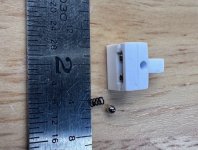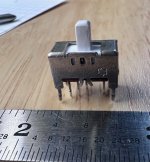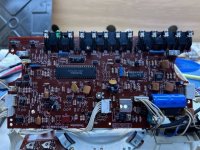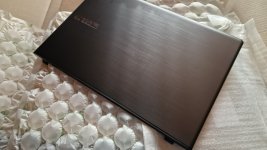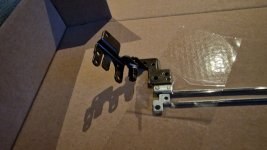Yesterday I changed the tonearm tube of the old Technics SL-1210 I started to refresh. I added some foam ear plugs inside the tonearm tube to damp the ringing of the tube. Now I am listening to music, trying to decide if there is a difference or not 😂
I also repaired an old Dual CS-503-2. It features a chassis that is connected to the plinth through four rubber posts. Over the years the rubber posts aged and shrunk a bit, so that the platter started to scratch slightly on the plinth while turning. I had to take the turntable apart to realise the problem. I added four M6 washers underneath the rubber dampers and now the chassis with the plate and tonearm sits high enough to let the platter run free. This turntable will be send to mother-in-law soon.
I also repaired an old Dual CS-503-2. It features a chassis that is connected to the plinth through four rubber posts. Over the years the rubber posts aged and shrunk a bit, so that the platter started to scratch slightly on the plinth while turning. I had to take the turntable apart to realise the problem. I added four M6 washers underneath the rubber dampers and now the chassis with the plate and tonearm sits high enough to let the platter run free. This turntable will be send to mother-in-law soon.
Marconi TF2304 modulation meter, analog meter was not working, but the rest was ok, incredible a shorted 47uf/10v as filtering after a simple rectifier diode of the demodulated AF was shorted solid. Replaced the cap and the meter was fine…
SB
SB
You should change the dampers, once rubber starts to disintegrate, it will crumble over time.
Sounds reasonable, will look for those parts. Thank you!
Been on my mind for a while, both for cold and for sound...Insulation, I think, is what you had in mind.
Just finished a complete restoration of a Technics SL-6. When I received it albums would play normally, but the programming functions were completely out-of-whack. Several of the electrolytics were bad, and at least one previous attempt at "restoration" resulted in the almost complete disintegration of the contact carriers in the two slide switches controlling disc diameter and sensor level. As these are unobtainium, they were rebuilt from scratch using styrene and X-acto knives (and a boatload of patience!).
The first picture shows the completed carrier prior to installation of the detent ball and spring (the curved sides don't exist, they're due to lens distortion). Final adjustment of the finished deck per the service manual was difficult, but finally yielded excellent results!
The first picture shows the completed carrier prior to installation of the detent ball and spring (the curved sides don't exist, they're due to lens distortion). Final adjustment of the finished deck per the service manual was difficult, but finally yielded excellent results!
Attachments
A Mac Mini with a growling fan. After buying a special tool to crack open the case, you have
to pretty much take it all apart to get to the fan. Then vacuum out all the dust, replace the
backup battery, and install the new fan. I guess for being 14 years old, $65 isn't bad to keep it running.
to pretty much take it all apart to get to the fan. Then vacuum out all the dust, replace the
backup battery, and install the new fan. I guess for being 14 years old, $65 isn't bad to keep it running.
Timing chain on a 2004 Honda CRV. Intake cam slipped with 250K miles on it. Chain had gotten a little longer than the replacement and the tensioner seemed to have a little extra spring sticking out of it.
Meridian 508 /24 . Changed laser head and it worked like new and I was pleased with myself . Turned it off , went for a monthly trip. Upon return I made myself a cup of tea turned on my CD player and all I hear was ZZZZzzzzzz and when I hit Open, the disc in the drawer was spinning backwards with the speed of light. I decided to give it a little bit of time. After 3 days of Zzzzzz and backwards spinning I gave up. I left it powered on and went for a three weeks trip.
I'm back now AND the player works like new again ...I promised myself to never turn it OFF.
I'm back now AND the player works like new again ...I promised myself to never turn it OFF.
Sony STR-V45L. The problems was the following: FM Stereo, FM muting buttons, automatic FM stations search.
All was caused by the 7.2Mhz PLL quartz, that was untuned. I bought some in Aliexpress, but I had to put a 18pF capacitor in the quartz pins for to carry the oscillator to 7200khz.
Then I adjusted following Service Manual instructions, and now is perfect. I have another STV-V45 with the same problem, but this one another time.
All was caused by the 7.2Mhz PLL quartz, that was untuned. I bought some in Aliexpress, but I had to put a 18pF capacitor in the quartz pins for to carry the oscillator to 7200khz.
Then I adjusted following Service Manual instructions, and now is perfect. I have another STV-V45 with the same problem, but this one another time.
This makes me think of asynchronous motors that can rotate one way or the other. They need a trick to force the desired way at start up, usually implemented with an additional winding and a series capacitor.
Fixed a software bug in a DCC model railway controller.
For it to work properly the decoder needs to see DCC signals as often as possible.
Otherwise loco times out and slows down to a stop.
I put controller on a scope and it outputs DCC data for about 10ms then outputs nothing for about 100ms.
100ms is too long really.
The software goes through loco addresses 1 to 9999 and then searched for each in a table, which took forever.
I found a better way that instead looks through table and uses loco data to send from the table. No search involved.
So why didn't I do that first time ?
The software was pinched from another project where the data table isnt sequential.
In the new software it is so can be done faster.
For it to work properly the decoder needs to see DCC signals as often as possible.
Otherwise loco times out and slows down to a stop.
I put controller on a scope and it outputs DCC data for about 10ms then outputs nothing for about 100ms.
100ms is too long really.
The software goes through loco addresses 1 to 9999 and then searched for each in a table, which took forever.
I found a better way that instead looks through table and uses loco data to send from the table. No search involved.
So why didn't I do that first time ?
The software was pinched from another project where the data table isnt sequential.
In the new software it is so can be done faster.
Large, heavy, ornate glazed plant pot broken by accident. Only three large pieces so glued at once and held in place with tons of cable ties.
Araldite std is wonderful stuff.
Finished up with seams it was hard to detect with a finger nail. Was rather chuffed.
Araldite std is wonderful stuff.
Finished up with seams it was hard to detect with a finger nail. Was rather chuffed.
Years ago (we're talking COBOL) I was given a program to fix that was taking hours to run because of slow table searching. I pre-sorted the input file and did a simple binary chop search. Run time went from 4h+ to 3s (it was a huge table) including the sort. It finished so quickly production people assumed it was failing...In the new software it is so can be done faster
Now we have nonsql.. i was told recently to process some data it would take 150hours.. if the damn thing was built right it would have been seconds.. sometime the recent fads aren’t the best..Years ago (we're talking COBOL) I was given a program to fix that was taking hours to run because of slow table searching. I pre-sorted the input file and did a simple binary chop search. Run time went from 4h+ to 3s (it was a huge table) including the sort. It finished so quickly production people assumed it was failing...
My favourite is the java programmer’s first reaction is to pull each row out of the database across the network and into a server.. row by row.. it’s database based on set theory..
A mate of mine had a similar story - he used to work at oracle looking after hundreds of databases, and customers think looking after single digit databases is difficult! The number of bad performing database processes is staggering.. many can be quickly adjusted to complete not in hours or days but milliseconds or minutes.
Last edited:
- Home
- Member Areas
- The Lounge
- What did you last repair?
